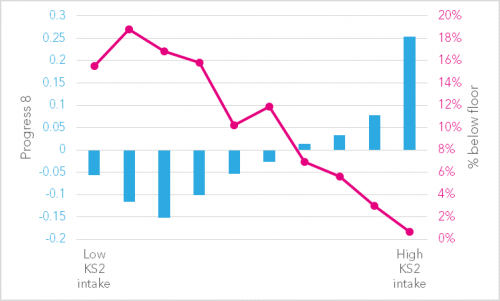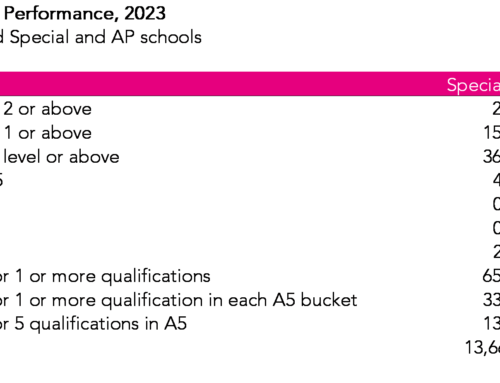Last year we reported on how schools serving more affluent pupil communities are likely to achieve much better Progress 8 scores. It isn’t immediately obvious that this should be so, since the Attainment 8 GCSE score for a child is always compared to other children who scored exactly the same Key Stage Two (KS2) fine grade. The expected Progress 8 for pupils is, by construction, zero at every KS2 fine grade.
However, once we average pupils’ Progress 8 scores in a school, it becomes clear that there is a relationship between the school’s intake attainment and Progress 8. This is shown for 2015 in Figure 1 below (the blue bars are the average Progress 8 by decile of school intake). It has real consequences for the accountability threat to schools since those with lower ability intakes are far more likely to fall below the announced floor standard of -0.5 (pink line on chart), although this new floor standard is clearly fairer than the old 40% 5+A*-C one.
Figure 1: Average Progress 8 score in 2015 (by average KS2 intake decile) on LH-axis (blue); percentage of schools falling below the floor standard of -0.5 P8 in 2015 on RH-axis (pink)

One simple reason why this relationship exists is that schools with higher ability intakes enter students for subjects that are better aligned with the Progress 8 measure. As all schools altered their KS4 curriculum to become better aligned we expect these stark differences in numbers falling below the new floor to gradually fall over time. However, it is unlikely to disappear – we can observe a similar gradient in individual subjects such as maths and English where issues of curriculum alignment are not relevant.
Whether or not this gradient is fair rather depends on why the relationship exists and what the purpose of the measure is. If it is because pupils in schools have clustering of social circumstances so that a low attaining pupil who attends a relatively affluent school is likely to have a supportive home environment then Progress 8 would seem unfair to schools serving disadvantaged communities, unfit as an indicator for school performance for parents and a weak accountability measure. It is unfair to the schools themselves because it is almost impossible for them to compensate for home environment. It is unfit as an indicator to inform school choice because parents might wrongly infer their child is likely to underperform in the school. And it is a weak accountability measure because we hold some schools responsible for things outside their control, whilst others can ‘coast’ without fear of intervention.
On the other hand, it is a perfectly reasonable measure of school performance if the relationship arises because there are greater numbers of effective schools serving affluent communities than there are those serving deprived communities. This seems quite likely given the known relationship between the level of school disadvantage and the turnover rate of its teachers, the struggle of schools with lower ability intakes to recruit specialist teachers for shortage subjects and headteachers.






Leave A Comment